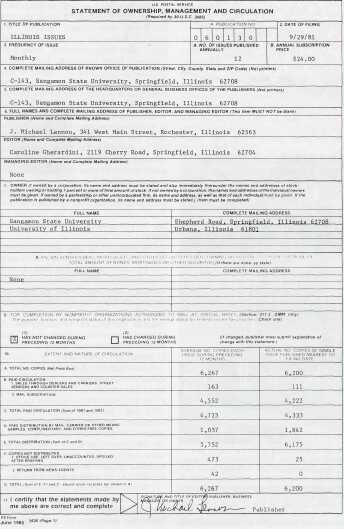 |
Home | Search | Browse | About IPO | Staff | Links |
 |
Home | Search | Browse | About IPO | Staff | Links |

 The state of the State The state of the StateBy DIANE ROSS Social services: angles and edges AS THE General Assembly's fall session drew to a close in late October, the Republican House had overridden some of Gov. James R. Thompson's social services vetoes and the Democratic Senate was expected to follow suit. But the real debate on the issue had only begun. How will the recession affect the delivery of social services in Illinois? How will federal budget cuts and state budget cuts affect the partnership — the dependency — between the public sector and the private sector here? Can the volunteerism that Reagan and Thompson preach fill the gap in the recession-plagued Midwest? Just who needs who? How much? How long? Thompson's vetoes and the General Assembly's overrides raised these questions, but don't let the politics of the veto session obscure the struggle. The delivery of social services is still a public sector-private sector issue — not a partisan issue — and the private sector, it appears, wants to keep it that way. The state budget for social services is divided into two parts: operations funds to run the public agencies, which administer the programs, and grant funds to reimburse the private agencies, which provide the services. It was Thompson's vetoes of grant funds for children and family services that raised the issue. The Democrats, in their role as the opposition party, mounted an all-out offensive to override what they considered the most crucial of the grants funds vetoes: $4.1 million for day care, $1.3 million for foster care, $972,000 for institutional care, $1.1 million for other kinds of child care, $7.9 million for the so-called "local initiative" social services (the 75 percent state match for local agencies which come up with the rest), $1.2 million for mental health and $380,000 for public health. But the real muscle behind the override offensive may have come from the private agencies that actually provide the social services. The private sector has organized what it calls "The Statewide Coalition on FY '82 Human Services Veto Reductions," a loosely knit group of 26 groups ranging from the Child Care Association of Illinois (which says its members provide 75 percent of the state's children and family public sector services) to the Illinois Conference of Churches, the United Way of Metropolitan Chicago and the League of Women Voters of Illinois. With the Democrats behind them, the coalition lobbied the Republicans. But the coalition didn't want social services to become a partisan issue. To that end, the coalition spent most of its time negotiating with Gov. Thompson, hoping to reach a compromise that would avoid the political entanglements of an override attempt. Restoring children and family services funds was the coalitions's short-term goal, but survival of the private sector agencies is its long-term goal. And whatever the outcome on day care, the coalition has already succeeded in raising the question of how state and federal budget cuts affect the partnership between the public and private sectors for the delivery of social services. Government got into the social services business during the Great Depression — and never got out. During Lyndon B. Johnson's "Great Society," government expanded social services. The resulting rise in the types of services and the caseload forced Illinois, like other states, to offer a subsidy if the private sector would help deliver the services. But the partnerhsip became a dependency: the state provided larger and larger subsidies, the private sector delivered more and more of the services. As a result, coalition leaders say, the public sector and the private sector, per se, no longer exist. In one specific case — aging — the state is the 4 | December 1981 | Illinois Issues 
administrator, but the private agencies provide the services under arrangements with the state. In the private sector, state grants to provide services may represent one-third of an agency's operating funds. The coalition leaders don't defend the status quo; they don't deny there are problems in delivering social services during an inflation-driven recession. They know federal government has cut aid to state government. But they argue that the state can't cut the subsidies (to offset cuts in federal aid) and still expect the private sector to deliver more services — not when the private sector already depends on the subsidies to make ends meet. The obvious solution, the coalition leaders say, is to redraw the lines between the public and private sectors and determine which services can be best provided by each sector. But that's more easily said than done. Next year is going to be worse than this year. All indications are that government budgets for social services are going to be cut. Thus services are going to be cut, but neither the public sector nor the private sector is going to want to take the blame. The private social service agencies, struggling to survive in the face of shrinking subsidies, may continue their efforts to organize as a lobby. These agencies, however, don't want to be aligned with either Democrats or Republicans, and as they indicated this fall, they don't want to become entangled in the legislature's politics. This new private agency lobby prefers to deal with the executive branch, but, of course, the governor belongs to one party or another. Thompson is up for reelection next year, and will attempt to keep the state solvent at all costs. But, at the same time, he will try to avoid antagonizing any special interest group. So the outcome of the negotiations over day care grams this fall will set the stage for some important bargaining over social services next year. December 1981 | Illinois Issues | 5 |
|
|